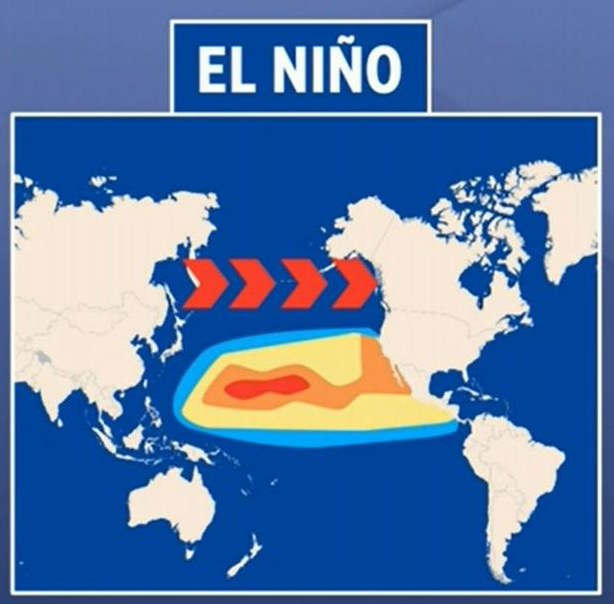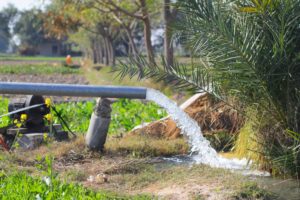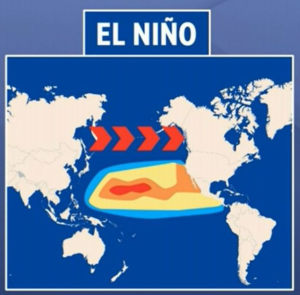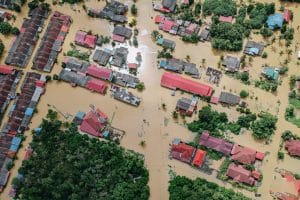1. What is El Nino phenomenon?
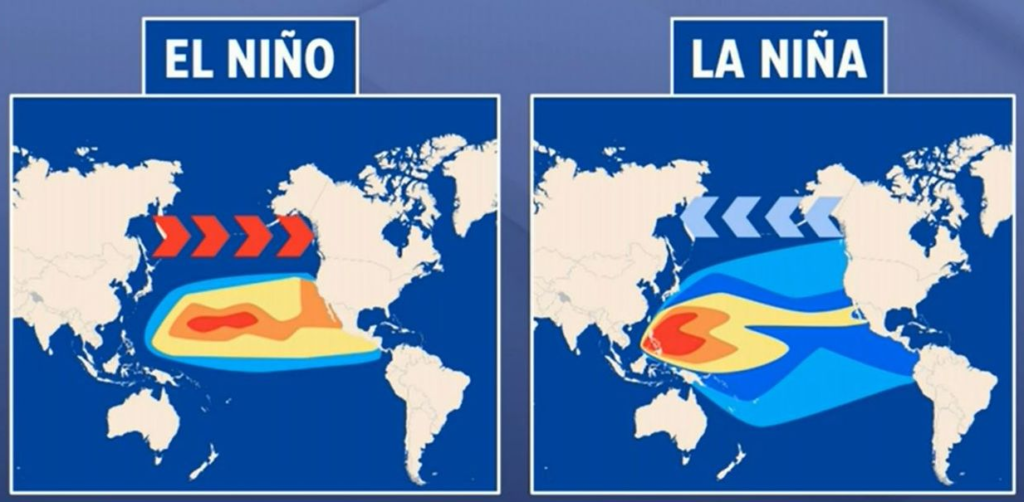
El Niño is a weather phenomenon that occurs when there is a warming of the surface water in the Pacific Ocean, specifically in the region around the equator. This warming can disrupt normal weather patterns and cause changes in rainfall and temperature across the globe. El Niño typically occurs every few years, and can last for several months to a year or more.
The consequences of El Niño can be significant, and can vary depending on the location and severity of the phenomenon. One of the most significant impacts of El Niño is on agriculture. In some parts of the world, El Niño can lead to drought conditions, which can cause crop failures and lower yields. This can have a devastating impact on farmers, who may lose their source of income and struggle to provide for their families. In addition, the impact on agriculture can have wider economic consequences, as the agricultural sector is an important contributor to many countries’ economies.
El Niño can also have an impact on global weather patterns, leading to changes in temperature, rainfall, and even the occurrence of extreme weather events such as hurricanes and floods. In some parts of the world, El Niño can lead to more frequent and severe storms, which can cause significant damage to infrastructure and homes. The impact of El Niño on weather patterns can also have an impact on the environment, leading to changes in ocean currents, sea level, and the distribution of plant and animal species.
In addition to its impact on agriculture and the environment, El Niño can also have consequences for human health. In some areas, El Niño can lead to the spread of water-borne diseases, as drought conditions can make it more difficult to access clean water. In addition, the occurrence of extreme weather events can put people at risk of injury or illness.
Overall, El Niño is a natural phenomenon that can have significant and far-reaching consequences for the world. By understanding the causes and effects of El Niño, we can work towards building more resilient and sustainable communities that are better able to withstand the impact of this and other natural phenomena.
2. El Nino’s effect in Philippines
The Philippines is no stranger to natural disasters, but one phenomenon in particular has brought devastation to the country time and time again – El Niño. This weather phenomenon, caused by a warming of the Pacific Ocean, can have disastrous consequences for the Philippines, including droughts, crop failures, typhoons and even food shortages. In this article, we will explore the far-reaching consequences of El Niño in the Philippines, from its impact on agriculture and the economy to its effects on people’s daily lives and try to anticipate its impacts for the end of 2023.
El Niño is a weather phenomenon that has plagued the Philippines for decades. It occurs when the surface temperature of the Pacific Ocean rises above average, causing changes in wind patterns and atmospheric circulation. This disruption in weather patterns can have serious consequences for the Philippines, which relies heavily on agriculture as a key source of income and food security. During El Niño years, the country is often hit with prolonged droughts, which can lead to crop failures and lower yields. In turn, this can result in higher food prices, putting a strain on the economy and making it difficult for many Filipinos to access basic necessities. This was particularly observed during the 1997/98 El Nino, where agricultural communities in the Philippines suffered widespread crop losses (Dawe et al., 2009 & Lopez and Mendoza 2004). Around 60% of rice production in the Philippines comes from the island of Luzon, with two main periods for rice harvesting (the principal from October to November and the second one, smaller, from March to April). The irrigation system development since the 1970’s years made possible to triple the rice production in this island during the dry season and now accounts for around 43% of the annual rice production (Roberts et al., 2009). Some farmers in irrigated systems are not adequately protected against drought due to limited storage capacity. Even when there is sufficient storage capacity in irrigation systems, the demand for water from urban and industrial sectors during drought periods can result in reduced water availability for agricultural purposes (Dawe et al. 2009). However, rainfed rice systems remain a very important resource for many poorer famers in the Philippines, and is again more susceptible to drought stress. Unlike previous studies, Roberts and al., 2009 found that both irrigated and rainfed rice systems were affected by El Nino phenomenon, although they are affected differently. The decline of production for the irrigated system found out to be mainly due to the decrease in area harvested and in dry season is associated with a decrease of 3.7% of the production, while the rainfed system suffered mainly from the droughts associated with the El Nino phenomenon and is associated with a 13.7% production decrease during the dry-season. Knowing this, with appropriate management of imports, stock and insurances for rainfed dependent farmers, it is possible to lower the El Nino effects in rice crop production impact on the populations, and especially the poorest populations, who proportionally spend the most of their income for rice.
The impacts of El Nino in the sea industries are multiple. This phenomenon can affect multiple parameters involved in the ocean such as surface temperature, salinity, nutrient availability, ocean current, tropical typhoons… This changes in the oceans could have important short-term or lasting effects such as the increase of phytoplankton biomass, widespread of coral bleaching and resulting to seaweed diseases, threat to marine mammal animals and fish kills (Damatac and Santos, 2016). This poses a great pressure to the livelihood and food security among the Filipinos, and especially the coastal communities where fish farms or fishing is the primary source of food and income for a large number of persons.
The impact of El Niño on agriculture is not just limited to individual farmers – it can also have far-reaching effects on the wider economy. Agriculture is a major contributor to the Philippines’ GDP, accounting for around 9% of the country’s total economic output. When crops fail and yields are lower, this can lead to a decrease in agricultural output, which in turn can have a negative impact on the economy as a whole. This can lead to higher food prices, which can make it more difficult for people to afford basic necessities. In addition, the impact on the agricultural sector can have a ripple effect on other industries, such as manufacturing and transportation, leading to further economic strain.
The effects of El Niño on the Philippines are not just limited to agriculture and the economy they can also have a profound impact on people’s daily lives. During El Niño years, many Filipinos may experience water shortages, as the lack of rainfall leads to depleted water sources. This can make it difficult to access clean water for drinking, cooking, and sanitation, and can lead to the spread of water-borne diseases. In addition, the drought can lead to forest fires, which can cause air pollution and respiratory problems for people living nearby.
The impact of El Niño on the Philippines is not limited to the immediate effects of drought and crop failure. The long-term consequences of the phenomenon can also be significant, particularly in terms of environmental degradation. Drought and deforestation can lead to soil erosion and reduced soil fertility, making it more difficult to grow crops in the future. In addition, the burning of forests and other vegetation during El Niño years can release large amounts of carbon dioxide into the atmosphere, contributing to climate change. As such, the consequences of El Niño in the Philippines can be felt long after the phenomenon has passed, affecting not just the current generation, but also future ones.
In conclusion, El Niño is a powerful weather phenomenon that has had far-reaching consequences for the Philippines. From its impact on agriculture and the economy to its effects on people’s daily lives and the environment, the consequences of El Niño can be devastating. Despite this, the country has shown remarkable resilience in the face of such challenges, with government agencies and non-governmental organizations working to mitigate the effects of El Niño on vulnerable communities. By understanding the causes and consequences of El Niño, we can better prepare for its impacts and work towards building more resilient and sustainable communities.
To go Further

